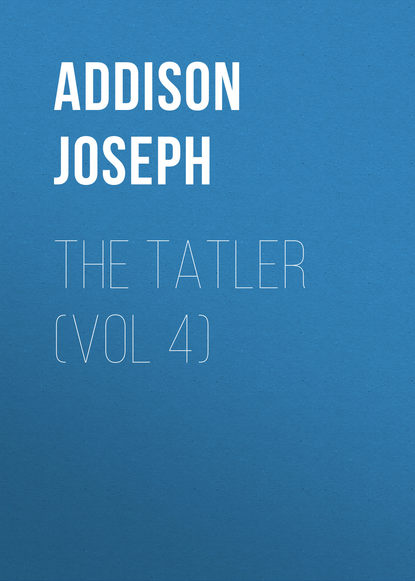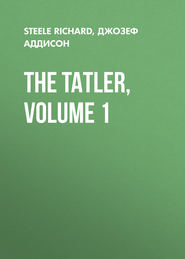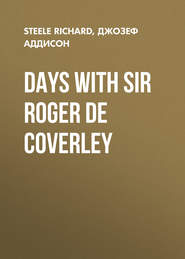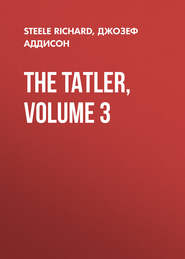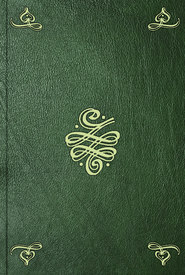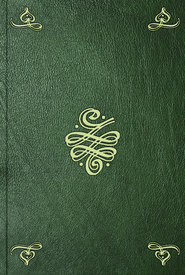По всем вопросам обращайтесь на: info@litportal.ru
(©) 2003-2024.
✖
The Tatler (Vol 4)
Настройки чтения
Размер шрифта
Высота строк
Поля
107
See No. 14.
108
The Physician was one of the usurping Kings of Brentford.
109
See No. 34
110
"Livide" (Martial).
111
"Paradise Lost," iv. 358 seq.
112
Nos. 214 and 220.
113
"Next Tuesday morning will be published the account of the alterations of wind and weather, by the discoveries of the portable barometer; from what quarter the wind will blow, clouds or rain, wind and weather, clear and cloudy, wet and dry, come every day and night for the month of October, all over England, and also when the quicksilver weather-glasses will rise in wet, and sink in fair weather, and rise and sink without any alteration at all. Whereas there was a false impression of the last month, to the great damage of the author, who has been at vast charge and expense to being so useful an invention to perfection, and to prevent the like for the future, it is hoped that those ingenious persons who are lovers of so useful a discovery will not encourage the false one, the true one being only to be had at W. Hawes, at the Rose in Ludgate Street, and A. Baldwin in Warwick Lane, where they shall be sent to any gentleman, if desired, monthly" (Post-Man, September 26, 1700). These "barometer papers" are ridiculed in The Infallible Astrologer, a paper published in 1700.
114
This almanac was first published in 1663. The title of it was assumed in ridicule of Dr. Robert Pory, a pluralist of the last century, who, amongst other preferments (such as the archdeaconry of Middlesex, a residentiaryship of St. Paul's, &c.), enjoyed the rectory of Lambeth. Pory died in 1669, and "Poor Robin's Almanac" professed to bear his imprimatur (see Wood's "Fasti," Part II., col. 267).
115
No. 224.
116
Daniel Burgess (see No. 66).
117
The first number of Tit for Tat appeared under the name of Jo. Partridge, Esq., on March 2, 1710, with an announcement of Bickerstaff's death; probably it reached only to five numbers. Of the Whisperer (October 11, 1709), and the Gazette à-la-Mode, or Tom Brown's Ghost (May 12, 1709), only single numbers are known. The Female Tatler, issued by Thomas Baker, lasted from July 8, 1709, to March 31, 1710; and there was a rival paper, with the same title, printed for A Baldwin. The "New Atalantis," Mrs. Manley's well-known book, contained more than one attack on Steele. "Annotated" refers to the satirical "Annotations upon the Tatler," 1710 (see No. 224); and "condoled," to a pamphlet, "A Condoling Letter to the Tatler; on account of the misfortunes of Isaac Bickerstaff, a prisoner in the – on suspicion of debt" (September 19, 1710). The Tory Examiner had much to say about the Tatler and Steele's subsequent writings. Nothing is known of a Re-Tatler.
"For my part," wrote Defoe, "I have always thought that the weakest step the Tatler ever took, if that complete author can be said to have done anything weak, was to stoop to take the least notice of the barkings of the animals that have condoled him, examined him, &c. He should have let every bark and fool rail, and, according to his own observation of the fable of the sun, continued to shine on. This I have found to be agreeable to the true notion of contempt. Silence is the utmost slight nature can dictate to a man, and the most insupportable for a vain man to bear."
118
"Faërie Queene," 1. i. 22, 23.
119
See No. 239.
120
Swift was author of the letter which fills the remainder of this paper. See his "Journal to Stella," Sept. 18, 1710: "Got home early, and began a letter to the Tatler about the corruptions of style and writing, &c." Sept. 23, 1710: "I have sent a long letter to Bickerstaff, let the Bishop of Clogher smoke it if he can." Sept. 29, 1710: "I made a Tatler since I came; guess which it is, and whether the Bishop of Clogher smokes it." Oct. 1, 1710: "Have you smoked the Tatler that I wrote? It is much liked here, and I think it a pure one."
121
Thomas Harley, minister at the Court of Hanover, and cousin of Robert Harley, afterwards Earl of Oxford. He died in 1737.
122
This story is simply that of Katherine and Petruchio, in "The Taming of the Shrew," retold. It would seem that Steele was able to count upon his readers having very little knowledge of Shakespeare.
123
See No. 230.
124
See Nos. 155, 160, and 178.
125
Sacheverell's.
126
The Moderator, which professed to discuss the arguments of both parties impartially, lasted from May to November 1710.
127
No. 7 of the Examiner contained what purported to be a letter from a Swedish officer at Bender to his friend at Stockholm.
128
See Nos. 38 and 230.
129
This letter refers to the one by Swift in No. 230, on the corruptions of the English language in ordinary writings. The present letter, which is supposed to be by James Greenwood, closes with the statement that an English grammar, with notes, would be published next term. Soon afterwards there appeared, with the date 1711, "A Grammar of the English Tongue, with Notes… Printed for John Brightland," &c. This book was noticed in the Works of the Learned for November 1710. Facing the title is a page bearing the head of Cato the Censor, and the following lines: "The Approbation of Isaac Bickerstaff, Esq.: 'The following treatise being submitted to my censure, that I may pass it with integrity, I must declare, that as grammar in general is on all hands allowed to be the foundation of all arts and sciences, so it appears to me that this Grammar of the English Tongue has done that justice to our language which, till now, it never obtained. The text will improve the most ignorant, and the notes will employ the most learned. I therefore enjoin all my female correspondents to buy, read, and study this grammar, that their letters may be something less enigmatic; and on all my male correspondents likewise, who make no conscience of false spelling and false English, I lay the same injunction, on pain of having their epistles exposed in their own proper dress in my Lucubrations. – Isaac Bickerstaff, Censor.'" There is a Dedication to the Queen, and a Preface in which "the Authors" explain how they have come to undertake a much-needed work at the request of Mr. Brightland.
This book was followed by a pamphlet of six pages, "Reasons for an English Education, by teaching the Youth of both Sexes the Arts of Grammar, Rhetoric, Poetry, and Logic, in their own Mother-Tongue, 1711." On p. 5 the writer asks, "Has our Censor complained without cause, and given a false alarm of danger to the language of our country? (Lucubrat., Sept. 28, 1710);" and on the next page we are told that I. B., encouraged by the success of his book, was industriously correcting it for a second edition. This appeared in 1712, with an increase in the number of pages from 180 to 264. Other editions appeared in 1714 and 1720. The fifth is dated 1729, and is advertised in the Craftsman for July 5, 1729, as "recommended by Sir Richard Steele, for the use of the schools of Great Britain;" but according to the Monthly Chronicle, it really appeared on August 8, 1728, being called in the Index, "Bickerstaffe's Grammar." The seventh and eighth editions were published in 1746 and 1759.
In Nos. 254 and 255 of the Tatler there was advertised, as shortly to be published, "An Essay towards a Practical English Grammar, by James Greenwood… Particular care has been taken to render this book useful and agreeable to the Fair Sex." This book is dated 1711, and is noticed in the Works of the Learned for July. The Preface gives "part of a letter which I wrote about a twelvemonth ago to the ingenious author of the Tatler upon this head" (i. e. knowledge of grammar among the fair sex). Greenwood's remarks on female education were not printed in the Tatler; but they may have formed part of the letter in this number (234), if this letter is by Greenwood. The third edition, enlarged, of Greenwood's "Essay" appeared on May 24, 1729. Greenwood was sub-master at St. Paul's School, and afterwards kept a boarding-school at Woodford, in Essex. He published "The London Vocabulary, English and Latin," of which there was a third edition in 1713, with curious illustrations. By 1817 this book had passed through twenty six-editions in England, besides several in America. Greenwood also published in 1713 "The Virgin Muse," a collection of poetry for "young gentlemen and ladies at school." Second and third editions appeared in 1722 and 1731.
Michael Maittaire also issued, in 1712, "An English Grammar; or, an Essay on the Art of Grammar, applied to and exemplified in the English Tongue." In the same year a pamphlet appeared with the title, "Bellum Grammatical, or the Grammatical Battle-Royal. In Reflections on the three English Grammars published in about a year last past." It consists chiefly of an attack on Greenwood's "Essay," and praise of Brightland's "Grammar," which "merits what the Censor said of it." In a postscript Maittaire's "Grammar" is described as the worst of all. Brightland and Greenwood deserve to be remembered for their efforts to spread abroad a knowledge of "the genius and nature of the English tongue." (The facts in this note are taken from a paper by the present writer in Watford's Antiquarian for October 1885.)
See No. 14.
108
The Physician was one of the usurping Kings of Brentford.
109
See No. 34
110
"Livide" (Martial).
111
"Paradise Lost," iv. 358 seq.
112
Nos. 214 and 220.
113
"Next Tuesday morning will be published the account of the alterations of wind and weather, by the discoveries of the portable barometer; from what quarter the wind will blow, clouds or rain, wind and weather, clear and cloudy, wet and dry, come every day and night for the month of October, all over England, and also when the quicksilver weather-glasses will rise in wet, and sink in fair weather, and rise and sink without any alteration at all. Whereas there was a false impression of the last month, to the great damage of the author, who has been at vast charge and expense to being so useful an invention to perfection, and to prevent the like for the future, it is hoped that those ingenious persons who are lovers of so useful a discovery will not encourage the false one, the true one being only to be had at W. Hawes, at the Rose in Ludgate Street, and A. Baldwin in Warwick Lane, where they shall be sent to any gentleman, if desired, monthly" (Post-Man, September 26, 1700). These "barometer papers" are ridiculed in The Infallible Astrologer, a paper published in 1700.
114
This almanac was first published in 1663. The title of it was assumed in ridicule of Dr. Robert Pory, a pluralist of the last century, who, amongst other preferments (such as the archdeaconry of Middlesex, a residentiaryship of St. Paul's, &c.), enjoyed the rectory of Lambeth. Pory died in 1669, and "Poor Robin's Almanac" professed to bear his imprimatur (see Wood's "Fasti," Part II., col. 267).
115
No. 224.
116
Daniel Burgess (see No. 66).
117
The first number of Tit for Tat appeared under the name of Jo. Partridge, Esq., on March 2, 1710, with an announcement of Bickerstaff's death; probably it reached only to five numbers. Of the Whisperer (October 11, 1709), and the Gazette à-la-Mode, or Tom Brown's Ghost (May 12, 1709), only single numbers are known. The Female Tatler, issued by Thomas Baker, lasted from July 8, 1709, to March 31, 1710; and there was a rival paper, with the same title, printed for A Baldwin. The "New Atalantis," Mrs. Manley's well-known book, contained more than one attack on Steele. "Annotated" refers to the satirical "Annotations upon the Tatler," 1710 (see No. 224); and "condoled," to a pamphlet, "A Condoling Letter to the Tatler; on account of the misfortunes of Isaac Bickerstaff, a prisoner in the – on suspicion of debt" (September 19, 1710). The Tory Examiner had much to say about the Tatler and Steele's subsequent writings. Nothing is known of a Re-Tatler.
"For my part," wrote Defoe, "I have always thought that the weakest step the Tatler ever took, if that complete author can be said to have done anything weak, was to stoop to take the least notice of the barkings of the animals that have condoled him, examined him, &c. He should have let every bark and fool rail, and, according to his own observation of the fable of the sun, continued to shine on. This I have found to be agreeable to the true notion of contempt. Silence is the utmost slight nature can dictate to a man, and the most insupportable for a vain man to bear."
118
"Faërie Queene," 1. i. 22, 23.
119
See No. 239.
120
Swift was author of the letter which fills the remainder of this paper. See his "Journal to Stella," Sept. 18, 1710: "Got home early, and began a letter to the Tatler about the corruptions of style and writing, &c." Sept. 23, 1710: "I have sent a long letter to Bickerstaff, let the Bishop of Clogher smoke it if he can." Sept. 29, 1710: "I made a Tatler since I came; guess which it is, and whether the Bishop of Clogher smokes it." Oct. 1, 1710: "Have you smoked the Tatler that I wrote? It is much liked here, and I think it a pure one."
121
Thomas Harley, minister at the Court of Hanover, and cousin of Robert Harley, afterwards Earl of Oxford. He died in 1737.
122
This story is simply that of Katherine and Petruchio, in "The Taming of the Shrew," retold. It would seem that Steele was able to count upon his readers having very little knowledge of Shakespeare.
123
See No. 230.
124
See Nos. 155, 160, and 178.
125
Sacheverell's.
126
The Moderator, which professed to discuss the arguments of both parties impartially, lasted from May to November 1710.
127
No. 7 of the Examiner contained what purported to be a letter from a Swedish officer at Bender to his friend at Stockholm.
128
See Nos. 38 and 230.
129
This letter refers to the one by Swift in No. 230, on the corruptions of the English language in ordinary writings. The present letter, which is supposed to be by James Greenwood, closes with the statement that an English grammar, with notes, would be published next term. Soon afterwards there appeared, with the date 1711, "A Grammar of the English Tongue, with Notes… Printed for John Brightland," &c. This book was noticed in the Works of the Learned for November 1710. Facing the title is a page bearing the head of Cato the Censor, and the following lines: "The Approbation of Isaac Bickerstaff, Esq.: 'The following treatise being submitted to my censure, that I may pass it with integrity, I must declare, that as grammar in general is on all hands allowed to be the foundation of all arts and sciences, so it appears to me that this Grammar of the English Tongue has done that justice to our language which, till now, it never obtained. The text will improve the most ignorant, and the notes will employ the most learned. I therefore enjoin all my female correspondents to buy, read, and study this grammar, that their letters may be something less enigmatic; and on all my male correspondents likewise, who make no conscience of false spelling and false English, I lay the same injunction, on pain of having their epistles exposed in their own proper dress in my Lucubrations. – Isaac Bickerstaff, Censor.'" There is a Dedication to the Queen, and a Preface in which "the Authors" explain how they have come to undertake a much-needed work at the request of Mr. Brightland.
This book was followed by a pamphlet of six pages, "Reasons for an English Education, by teaching the Youth of both Sexes the Arts of Grammar, Rhetoric, Poetry, and Logic, in their own Mother-Tongue, 1711." On p. 5 the writer asks, "Has our Censor complained without cause, and given a false alarm of danger to the language of our country? (Lucubrat., Sept. 28, 1710);" and on the next page we are told that I. B., encouraged by the success of his book, was industriously correcting it for a second edition. This appeared in 1712, with an increase in the number of pages from 180 to 264. Other editions appeared in 1714 and 1720. The fifth is dated 1729, and is advertised in the Craftsman for July 5, 1729, as "recommended by Sir Richard Steele, for the use of the schools of Great Britain;" but according to the Monthly Chronicle, it really appeared on August 8, 1728, being called in the Index, "Bickerstaffe's Grammar." The seventh and eighth editions were published in 1746 and 1759.
In Nos. 254 and 255 of the Tatler there was advertised, as shortly to be published, "An Essay towards a Practical English Grammar, by James Greenwood… Particular care has been taken to render this book useful and agreeable to the Fair Sex." This book is dated 1711, and is noticed in the Works of the Learned for July. The Preface gives "part of a letter which I wrote about a twelvemonth ago to the ingenious author of the Tatler upon this head" (i. e. knowledge of grammar among the fair sex). Greenwood's remarks on female education were not printed in the Tatler; but they may have formed part of the letter in this number (234), if this letter is by Greenwood. The third edition, enlarged, of Greenwood's "Essay" appeared on May 24, 1729. Greenwood was sub-master at St. Paul's School, and afterwards kept a boarding-school at Woodford, in Essex. He published "The London Vocabulary, English and Latin," of which there was a third edition in 1713, with curious illustrations. By 1817 this book had passed through twenty six-editions in England, besides several in America. Greenwood also published in 1713 "The Virgin Muse," a collection of poetry for "young gentlemen and ladies at school." Second and third editions appeared in 1722 and 1731.
Michael Maittaire also issued, in 1712, "An English Grammar; or, an Essay on the Art of Grammar, applied to and exemplified in the English Tongue." In the same year a pamphlet appeared with the title, "Bellum Grammatical, or the Grammatical Battle-Royal. In Reflections on the three English Grammars published in about a year last past." It consists chiefly of an attack on Greenwood's "Essay," and praise of Brightland's "Grammar," which "merits what the Censor said of it." In a postscript Maittaire's "Grammar" is described as the worst of all. Brightland and Greenwood deserve to be remembered for their efforts to spread abroad a knowledge of "the genius and nature of the English tongue." (The facts in this note are taken from a paper by the present writer in Watford's Antiquarian for October 1885.)





